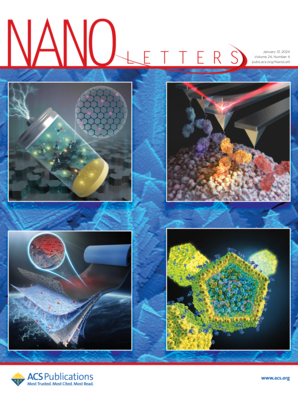基于晶界偏析的CoCrNi-CuZr薄膜双纳米复合材料设计
IF 9.6
1区 材料科学
Q1 CHEMISTRY, MULTIDISCIPLINARY
引用次数: 0
摘要
同时提高纳米结构材料的强度和塑性仍然是一个重大挑战。虽然晶粒细化在提高强度方面是有效的,但它通常会导致局部应变导致塑性降低。在这项研究中,我们提出了一种新的设计策略,即采用具有晶界偏析的双纳米复合结构来提高纳米结构材料的变形稳定性。采用CoCrNi-CuZr多主元素合金薄膜证明了这一策略,该薄膜显示出高密度纳米孪晶和结晶-非晶纳米复合的双纳米复合结构,并在柱状晶界处存在元素偏析。我们的策略在(CoCrNi)91(CuZr)9薄膜中实现了均匀的塑性变形,与纳米晶CoCrNi相比强度提高了18%,与非晶CuZr薄膜相比强度提高了67%。这些结果为通过双纳米复合结构工程设计高强度、延展性合金提供了有价值的见解。本文章由计算机程序翻译,如有差异,请以英文原文为准。

Dual-Nano Composite Design with Grain Boundary Segregation for Enhanced Strength and Plasticity in CoCrNi-CuZr Thin Films
Enhancing both strength and plasticity simultaneously in nanostructured materials remains a significant challenge. While grain refinement is effective in increasing strength, it typically leads to reduced plasticity due to localized strain. In this study, we propose a novel design strategy featuring a dual-nano composite structure with grain boundary segregation to enhance the deformation stability of nanostructured materials. This strategy is demonstrated using a CoCrNi-CuZr multiprincipal element alloy film, which shows a dual-nano composite structure with high-density nanotwins and crystalline–amorphous nanocomposite, along with elemental segregation at the columnar grain boundaries. Our strategy achieves homogeneous plastic deformation in a (CoCrNi)91(CuZr)9 thin film, an 18% increase in strength compared to nanocrystalline CoCrNi, and a 67% increase compared to amorphous CuZr thin films. These results provide valuable insights into designing high-strength, ductile alloys through the engineering of dual-nano composite structures.
求助全文
通过发布文献求助,成功后即可免费获取论文全文。
去求助
来源期刊

Nano Letters
工程技术-材料科学:综合
CiteScore
16.80
自引率
2.80%
发文量
1182
审稿时长
1.4 months
期刊介绍:
Nano Letters serves as a dynamic platform for promptly disseminating original results in fundamental, applied, and emerging research across all facets of nanoscience and nanotechnology. A pivotal criterion for inclusion within Nano Letters is the convergence of at least two different areas or disciplines, ensuring a rich interdisciplinary scope. The journal is dedicated to fostering exploration in diverse areas, including:
- Experimental and theoretical findings on physical, chemical, and biological phenomena at the nanoscale
- Synthesis, characterization, and processing of organic, inorganic, polymer, and hybrid nanomaterials through physical, chemical, and biological methodologies
- Modeling and simulation of synthetic, assembly, and interaction processes
- Realization of integrated nanostructures and nano-engineered devices exhibiting advanced performance
- Applications of nanoscale materials in living and environmental systems
Nano Letters is committed to advancing and showcasing groundbreaking research that intersects various domains, fostering innovation and collaboration in the ever-evolving field of nanoscience and nanotechnology.
 求助内容:
求助内容: 应助结果提醒方式:
应助结果提醒方式:


